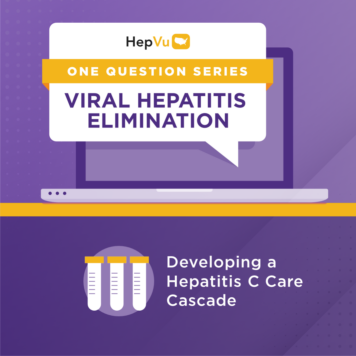Selected and summarized by Ronald O. Valdiserri, MD, MPH, Professor, Department of Epidemiology, Rollins School of Public Health, Emory University, and Co-Chair of HepVu.
Dr. Valdiserri reviews significant articles on prevention, public health, and policy advances in viral hepatitis. This month, he highlights “Hepatitis C Virus Clearance Cascade—United States, 2013—2022.” C Wester, Osinubi A, Kaufman W, et al. MMWR Morb Mortal Wkly Rep. 2023; 72 (26): 716-720.
What question(s) does this study address?
The Viral Hepatitis National Strategic Plan for the United States calls for 80% or more of the over 2 million persons with Hepatitis C in the U.S. to be cured (achieve viral clearance) by the year 2030. Being able to follow, at a population level, the cascade of Hepatitis C care from diagnosis of infection, through entry into treatment and eventual viral clearance is critical in order to determine progress toward achieving national elimination goals. However, surveillance reporting systems in most states are not currently able to routinely capture this information at a population level because each individual healthcare payer (for example, Medicaid, private insurance companies, community health centers, etc.) maintains its own, separate data system. In May 2023, the US Centers for Disease Control and Prevention (CDC) released guidance describing a simplified process for developing a standardized, laboratory result-based Hepatitis C clearance cascade. Using nine years of longitudinal data (January 1, 2013, through December 31, 2022) from a large national commercial laboratory, CDC recently published a national Hepatitis C clearance cascade in order to assess progress toward Hepatitis C elimination in the era of curative Hepatitis C treatment.
What are the major findings of this report/article?
- During January 1, 2013, through December 31, 2021, a total of 1,719,493 persons from all 50 states and the District of Columbia were identified as ever having been infected with Hepatitis C (including current and past infections) based on a positive test result.
- 88% of persons with laboratory evidence of Hepatitis C infection received viral RNA testing and among them, 69% (1,042,082) had detectable Hepatitis C RNA, that is, were positive for Hepatitis C virus.
- The prevalence of viral clearance (due either to cure because of treatment or spontaneous clearance without treatment) among persons with diagnosed Hepatitis C was 34% overall, and even lower (16%) among persons aged 20-39 years who were identified as “self-pay or client bill” in terms of insurance coverage.
- Persons with Medicare and commercial insurance had the highest rates of Hepatitis C clearance, 44.8% and 39.6%, respectively.
- 7% of those with viral clearance had evidence of subsequent viremia (due either to persistent infection or reinfection with Hepatitis C)
What are the implications for the prevention and control of viral hepatitis?
- Of the 1.0 million persons in this cascade identified with detectable Hepatitis C RNA, only one-third had evidence of viral clearance (cured or cleared).
- These findings highlight that there are significant missed opportunities to diagnose, treat, and prevent Hepatitis C in the United States.
- In addition to disparities in Hepatitis C clearance by insurance type, significant disparities in Hepatitis C clearance were observed based on age; regardless of payor (insurance) type, Hepatitis C clearance rates were lowest for persons under the age of 40.
- Taking full advantage of modern curative treatments for Hepatitis C will require changes in both health care delivery and financing systems. For example, outcomes could be improved by adopting automatic Hepatitis C RNA testing on all antibody positive samples as a strategy to prevent incomplete testing and by removing burdensome prior authorization requirements that pose barriers to timely Hepatitis C treatment.
- Investing in a national Hepatitis C elimination program could, on an annual basis, prevent thousands of deaths and save billions of dollars in health care costs in the United States.



